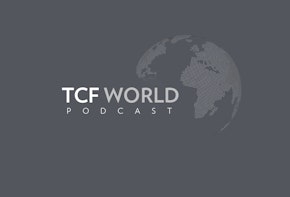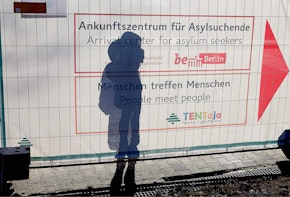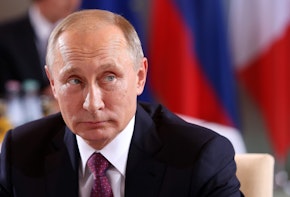Manbij, a city in northern Syria, hosted a compelling example of successful grassroots governance during the two-year period between the Syrian regime’s withdrawal from the city in 2012 and the Islamic State’s takeover in 2014. Drawing on hundreds of interviews conducted in Manbij in 2013, the author shows that the city established an innovative local political system during this interregnum. The new local government faced significant challenges, and made many mistakes, which the author discusses in detail. But those mistakes were not the undoing of Manbij’s revolutionaries. Instead, as in many other places in Syria, external forces derailed their efforts, buoyed by a Western narrative that seemed unable to even conceive of the kind of peaceful revolution under construction in Manbij. Still, Manbij’s experience holds important lessons—and could yet be the foundation for more participatory governance in Syria over the long term.
Twenty miles south of the Turkish border, on a plateau to the west of the Euphrates, lies the Syrian city of Manbij.1 With a population of two hundred thousand, it is located halfway between the cities of Aleppo and Raqqa, the latter of which is the de facto capital of the Islamic State. Manbij is a millennia-old city with a history, like so many urban places in Syria, of religious and ethnic diversity; it has passed through the hands of many empires, ranging from the Assyrians to the Ottomans. Today, the population is predominantly Sunni Arab but also includes several other religious and ethnic groups, including a sizable Kurdish minority.2
This place in the province of Aleppo was the setting for a remarkable eighteen-month period of participatory democracy, from July 2012 to January 2014, during which an entity called the Revolutionary Council (RC) controlled the city. In 2013 I was able to spend some three months in Manbij over the course of two visits, and witness firsthand its experiment in self-determined governance. I conducted around two hundred interviews with various actors in the city. My research opened a window onto a completely new perspective on Syrian revolutionaries (most refuse to describe themselves simply as members of the opposition)—one that completely bucked the simplistic mainstream narratives of Western media.3 Here, during an interlude of relative stability when neither the Syrian government nor foreign-backed jihadist groups had taken over the city, Syrians were deciding how to run their city for themselves. And they were excelling at it.
Here, during an interlude of relative stability when neither the Syrian government nor foreign-backed jihadist groups had taken over the city, Syrians were deciding how to run their city for themselves.And they were excelling at it.
More than five hours from Damascus by road in peacetime, Manbij was relatively early to throw off the yoke of Syrian president Bashar al-Assad’s regime, which local protesters managed to drive out in 2012. Despite the violence of the regime and military groups such as the Islamic State (which ultimately expelled the RC), and the intervention of a large number of regional and international players in the conflict, the eighteen months of locally guided government in Manbij were proof positive that Syrian society was able to produce an original democratic culture and creative alternative governance institutions that were vital to solving everyday problems.
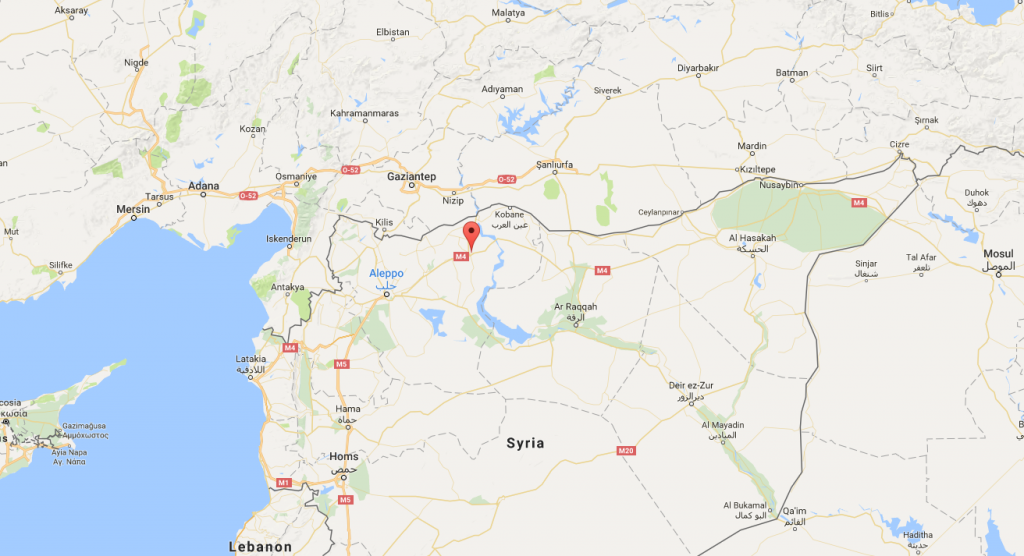
Syrian revolutionaries like those in Manbij didn’t speak the dominant academic Western language about social processes and revolutions—either because they couldn’t or were unwilling to. As a result, many journalists and academics have effectively denied them any form of agency. Many Western descriptions present them as mindless fighters who are easily manipulated by the different regional and global powers. This dominant narrative is a Eurocentric one that presents the revolutionaries as voiceless victims blown hither and thither by the winds of larger political processes.
The absence of discourses about grassroots processes in the revolution, however, doesn’t mean that those processes aren’t there. Rather, it is a result of deficiencies in analysis. Too often, the metanarrative of “secular tyrant versus bumbling Muslim insurgents” has blinded scholars and pundits to the possibility of the uprising’s piecemeal but significant achievements. A successful revolution became “unthinkable”4 to Western experts long before external forces had actually broken its back.
A successful revolution became “unthinkable” to Western experts long before external forces had actually broken its back.
This report is an attempt to stitch together a narrative that more adequately represents the grassroots efforts at governance that emerged between 2012 and 2014: they may have been fragmented, but they also formed an effective and constantly evolving whole. Revolutionaries actively experimented with new conceptual tools and with building alternative institutions on the ruins of the old ones. The revolutionary actions that might appear chaotic from afar acquire new meaning when scrutinized from the perspective of the population that they directly affected.
The Revolutionary Council
In the first half of 2012, a year after protests swept through Syria and many months after the protests had turned into war, Manbij was still under control of the regime of President Bashar al-Assad. Then, in May 2012, the government and allied militias massacred more than one hundred civilians in the town of Houla in northwestern Homs province. The incident was not particularly close to Manbij, but the slaughter, which counted dozens of women and children among its victims, galvanized anti-regime protesters around the country. In response, residents of Manbij organized protests. Marginal at first, they evolved into a general strike and open defiance of the police and security forces. The activists behind these protests came from different political backgrounds. Some of them were secular and others religious, but all utilized nonviolent strategies. Activists also created a Free Syrian Army (FSA) group—the FSA had been established nearly a year before—but its main function was to fight the regime in Aleppo and other cities.5 After the strike, which led to the shutdown of the entire city, the protests became larger and overwhelmed the security and police forces, who ultimately fled the city in July 2012.
The FSA gave pursuit, but was not the main factor in the security forces’ departure. News reports said that rebels had “captured” Manbij, but the reality is that there were only a few dozen fighters in the city. The peaceful movement was the real catalyst.6
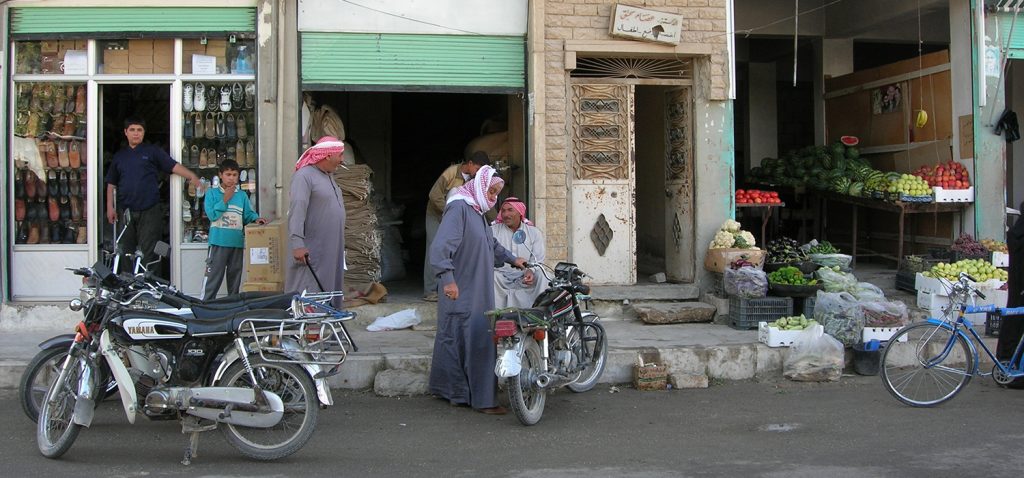
The RC had been founded in secret in April 2012, three months before the revolutionaries gained control of Manbij. During the initial period it mostly organized protests to expel the police and security forces, and coordinated with local and revolutionary councils in other cities. The members of the RC had diverse backgrounds, but the majority had a university education and came from middle-class families. Several were Syrian Ba’ath party members before March 2011. Members included lawyers, engineers, doctors, and teachers, in addition to a few Muslim scholars. The RC marginalized the religious establishment because of the latter’s collaboration with the regime and its refusal to take a clear stance in support of the revolution. While the person in charge of organizing the protests was the focal point of the group, others, such as the liaison between the RC and the FSA, played an important role as well. The FSA—which by now counted tens of thousands of fighters and controlled major swaths of the Syrian countryside—still had no significant presence in Manbij due to the vitality and momentum of the peaceful activists, who prevented the militarization of their activities to avoid the destruction of their city.
One of the achievements of the RC before liberation was the establishment of a network of more than fifty popular committees whose role was to protect the city and fill the vacuum on the day the security and the police would be forced to leave the city. So when the regime evacuated Manbij, the revolutionaries took over, and with the help of neighborhood committees, they prevented looting. The revolutionaries visited the different parts of the city to make sure that there were security checkpoints everywhere. The popular committees protected the entire city for three days, and not a single incident of violence or theft came to light. Revolutionaries had learned about such local organizing processes from Egyptian protesters who created their own popular committees in Alexandria, Cairo, and other cities to protect their neighborhoods from the regime’s thugs and other criminals during the first stage of the 2011 uprising in Egypt.7 The RC’s tremendous success in organizing protests, forcing the police and security to leave the city, filling the political and administrative vacuum, and protecting residents during the transitional period made it very popular. Despite certain missteps, such as the marginalization of important activists and the inability to raise enough funds, the RC was able to govern for several months without much opposition because its members had symbolic capital and revolutionary legitimacy.
While the RC was able to address many urgent issues with creativity and openness, several groups challenged it because they disagreed with its politics, creating a real fracture in the city. After liberation, there were several centers of influence in Manbij. The RC had the most legitimacy because of its organizing efforts prior to liberation and the risks its members took during that period. It was composed of the representatives of the different neighborhood committees, who were active members of the community prior to the revolution and had a vast network of contacts.
But there was another center of power, revolving around Mohammed al-Bishir, an ambitious architect who felt marginalized. He didn’t possess much legitimacy in the streets of Manbij, but was able to build a coalition with the individuals and families that were sidelined—intentionally or accidentally—by the RC. His coalition comprised more than twenty new groups and organizations that formed in 2012 and 2013. Some of them were active and had many members while others were ghost organizations created for the sole purpose of increasing the number of groups on Bishir’s roster. Many were professional organizations: journalists, lawyers, doctors, teachers, religious clerics, and engineers. Others represented women, the youth, and the media. The coalition elected Bishir to the presidency of a new local council in December 2012, in an attempt at undermining the popularity of the RC, but failed to do so.
Besides these two major nodes of power, there were several other groupings with more or less political weight that had an influence on events after the liberation. The Islamic religious institutions were one such grouping, but they remained marginal in 2012 due to their unwillingness to take a clear stance against the regime when the city was still controlled by the regime. Some of the young Muslim clerics were active in the protests but the religious establishment, which feared a backlash from the regime, did not support them.
Family affiliations made for another axis of power in Manbij, especially the clans. Every tribe in the Arab world is composed of several clans with uneven access to resources and power; about 15 percent of Syrians belong to a tribe. Certain clans within the same tribe sometimes had competing interests. Manbij’s clans8 were split in their allegiances, and as such didn’t have much leverage on their members. Despite most clans’ marginal role in the protests, some of them made more substantive contributions. For example, the al-Bou Banna clan had taken a clear position against the regime and many of their members were actively participating in the demonstrations. Most clans’ sheikhs, however, were close to the regime and had left Manbij early on, fearing reprisal from the population.
The city’s notables formed another cohort of consequence in the city. Local dignitaries who belonged to powerful and respected Manbij families, they had been used by the regime before 2012 as intermediaries, to control the residents. They played an important role during the protests and after liberation, as they were frequently asked to mediate between the security and the protesters. After liberation, the RC consulted them whenever it was time to make an important decision.
In addition to operating within a multipolar sociopolitical scene, the RC faced three main challenges after the liberation of the city. First, it didn’t have any financial resources to run vital institutions. Second, it didn’t have the necessary expertise to operate the mills or to administer the various branches of the council. Finally, the RC was unable to prevent the creation of numerous military formations. Powerful families and wealthy individuals in Manbij could form their own FSA brigade. The day of liberation, there were two FSA groups, while three weeks later their number increased to more than thirty, and by 2013 there were seventy. And the RC was losing legitimacy because of its inability to effectively protect the population from the harassment of certain FSA groups.
The presence of various military groups in the city caused old feuds to resurface, which prompted certain families and clans to establish their own military formations. While most of these formations were fighting Assad’s regime, a sizable number were coercing the locals into paying tributes and taxes. One such group was led by a local thug, who called himself “the Prince” (using the English word). He used his charisma to recruit fighters and later began looting other cities and kidnapping residents for large ransoms.9 This enabled him to amass the necessary funds to build a large FSA faction that, at its peak, had several hundred fighters.10 His group was affiliated with the Farouq Brigades, a large grouping of rebels within the FSA,11 but he avoided a confrontation with the regime to focus his attention on illegal activities and increase the size of his group. Since the Prince didn’t want to clash with the inhabitants of Manbij, his natal city, his kidnapping operation focused on the nearby city of Raqqa. The larger and more powerful FSA brigades disapproved of his actions but were too busy fighting the regime at the front to send fighters to Manbij to arrest or expel him. Ahrar al-Sham, one of the largest and most powerful jihadist groups, finally decided to confront the Prince and use him as an excuse to access Manbij and establish a headquarters there; they entered the city in February 2013. This strategy of coming to the rescue of the inhabitants was not unique to Manbij. Many groups used it to justify their invasion of a city and the subsequent takeover of buildings to establish their headquarters. The Nusra Front (which renamed itself the Fateh al-Sham Front in July 2016) used the same strategy to establish a presence in Manbij.
The RC was further marginalized when jihadist groups such as Ahrar al-Sham entered the city. While the RC tried to be democratic and inclusive by creating the Council of the Trustees (which we will discuss more below), the revolutionaries were unable to mobilize a large segment of the population. Their isolation allowed opposing forces to mount an effective opposition to the council.
As we have seen, the RC was very powerful immediately after the liberation of Manbij, because of the prior struggles of its members. The revolutionaries built credibility and gained symbolic capital before they took control of the city. Once they had it, they used the legitimacy they had accumulated during the previous period to build their strength. Still, the challenges we have listed stymied them, and evolved into even more complicated problems: a lack of funding; a lack of expertise to run institutions; an inability to provide the necessary resources to the internally displaced living in the city; the failure to prevent military groups’ intimidation of the residents; an inability to stop the threat and violence of the regime; their unwillingness to create an inclusive space for individuals and groups critical of the revolution; the social pressure to resolve everyday problems quickly (which in turn was difficult because of their other challenges); and the inability to build a solid front against the jihadist groups. The Islamic State capitalized on each one of these weaknesses to capture the institutions one by one and later, the entire city.
Council of the Trustees of the Revolution
To regain its legitimacy after numerous setbacks, the RC decided to create a Council of the Trustees of the Revolution (CTR), a legislative formation of six hundred residents who had a reputation as revolutionaries. While women were excluded, the CTR did make efforts to be more inclusive than the RC had been thus far. Many new groups and individuals were invited to join. The council had weekly meetings to discuss issues proposed by the members. The CTR made all the important decisions, such as raising the price of bread (the RC controlled an important mill and grain silos in Manbij) or the creation of a police force in the city, while the RC implemented these resolutions.
However, the CTR’s attempts at greater inclusion had limits, and the selection of members was controversial: many activists critical of the RC were not invited to join the CTR. While the RC argued that the new council should only be open only to revolutionaries (those who participated in demonstrations, fought the regime forces, or supported the revolution publicly or financially), others wanted to include everyone except for those who collaborated with the regime or took a clear stance against the revolution.
The CTR’s revolutionary/counter-revolutionary binary would come back to bite it. But in the beginning, tensions gave way and the CTR created a unique space where another kind of politics could be imagined. The meetings facilitated passionate debates about politics, democracy, military strategy, relief work, and various social issues. Any member of the CTR had the opportunity to discuss topics he deemed important. Unlike any other form of political consultation in recent memory in Manbij, the CTR discussed human rights with dignity, in the context of the vernacular culture’s notions about respect and piety. The CTR was an experimental space par excellence where grassroots politics, experimental processes, and participatory democracy could thrive. The meetings were organized on a biweekly basis and usually started at seven o’clock in the evening, running until around midnight. They were held at the headquarters of the Revolutionaries of Manbij Battalion in the city’s eastern outskirts. Since the regime had information about these meetings through its informants, it sometimes flew jets over them to intimidate participants—and impress upon them the futility of their efforts. Still, the CTR created a public sphere for debate and was very effective in preventing the FSA and other military groups from controlling the city’s institutions.
The CTR gave new momentum to the RC, but it didn’t last long. The RC made a serious political mistake by excluding a large section of the population. Their minimalist definition of who qualified as “revolutionary” was polarizing. Many in Manbij were insulted by their exclusion from the council, and consequently by their implicit categorization as counter-revolutionary. For its part, the RC purported to have made its classification to protect the CTR from the infiltration of counter-revolutionary forces, which were undeniably present in the city. Manbij was the target of weekly airstrikes and many informants provided vital information to the regime. In addition, a section of the population passively supported the regime for a variety of reasons. By imposing such an exclusive definition of “revolutionary,” the RC prevented many neutral or passive citizens from joining the CTR. As a result, it was easy for truly counter-revolutionary forces to convince the population that a few families and notables controlled the trustees while the vast majority of common people were excluded from decision-making.
Groups such as Ahrar al-Sham and the Islamic State began questioning the legitimacy of the CTR and recruiting the residents who felt disenfranchised. Some of the excluded groups gradually built relationships with sympathizers within the CTR, but more importantly, they began organizing against the CTR from the outside. The jihadist groups and their allies used an array of tactics to undermine the legitimacy of the council. They organized lively public debates in mosques about theology and Islam. At night, they held rallies in the city center, closing streets and playing jihadist songs. In some cases, they kidnapped and assassinated members and supporters of the RC. They used intimidation and violence to take over mosques that were under the control of the Sufi12 establishment and used them as spaces to propagate jihadist ideologies. In several instances, a preacher from the Islamic State would enter the mosque with an explosive belt and a machine gun and tell the imam to leave.
The jihadist groups and their allies used an array of tactics to undermine the legitimacy of the council. They organized lively public debates in mosques about theology and Islam.
In addition, the Islamic State would ask its supporters to be present to create a threatening environment if the imam refused to obey. In July 2013, the Islamic State kidnapped Sheikh Said Mohammed al-Dibo, the imam of the Grand Mosque, because of his refusal to obey their orders. A large demonstration was organized the same day and the Islamic State finally released the imam after several factions of the FSA threatened to take action. But the imam was killed one early morning a few weeks later, on his way to the mosque; the Islamic State was considered the most likely assassin. The Islamic State undermined the power of the RC by taking over vital institutions such as the mills and the bakeries. They organized protests against the RC for failing to control the prices of basic commodities or to stabilize the dollar’s exchange rate. Finally, they threatened to assassinate the president and members of the RC, and succeeded in creating a climate of fear.
The Revolutionary Court
After the liberation of the city in 2012, the RC started a process of deliberation with various forces in Manbij to establish a court. The Revolutionary Court was created two months later. It was one of the first revolutionary courts in the liberated areas, but the process of setting it up was somewhat contentious. The religious establishment wanted a religious court and a legal code based on sharia. On the other side were lawyers and revolutionaries who wanted to preserve the Syrian penal code and strip it of any articles created by the Assad regime. Lawyers argued that the Syrian penal code was approved in 1949, almost twenty years before Hafez al-Assad’s rise to power, and was thus still useful. In addition, article 3 of the 1973 constitution states that “Islamic jurisprudence is a primary source of legislation,” which they took to mean that there was no conflict between the penal code and sharia. Lawyers also argued that only a few articles of the penal code were introduced by either Hafez or Bashar al-Assad’s regime, and as such they could be easily removed. Due to these differences of opinion it took the Revolutionary Court several months before finding a suitable location to operate, and to agree on a penal code that suited both parties. In the end, a council of lawyers and clerics was formed and instead of employing the Syrian penal code, the RC decided to adopt “the Arab Unified Penal Code,” which was drafted by the Arab League in 1996 and was more in step with sharia than Syria’s code was. Practically speaking, however, many lawyers still followed the Syrian penal code since they were familiar with it, and with a few exceptions, Muslim clerics did not disapprove of the rulings since they had no experience with either.
When families of prisoners began bribing the guards for favors, the power of the Revolutionary Court was undermined.
The Revolutionary Court faced additional challenges, some internal and others external. Internally, the lack of funding prevented the court from having a police force to protect lawyers from retaliation and to enforce the court’s rulings. The judges felt vulnerable and unable to inflict harsh rulings—which were viewed as necessary in a time of war, according to some victims. As a result many of the more serious cases were tried in the Islamic State’s religious court. Also, the Revolutionary Court was unable to pay its guards adequately, which made them vulnerable to corruption; some were always seeking extra cash to complement their meager salaries. When families of prisoners began bribing the guards for favors, the power of the Revolutionary Court was undermined.
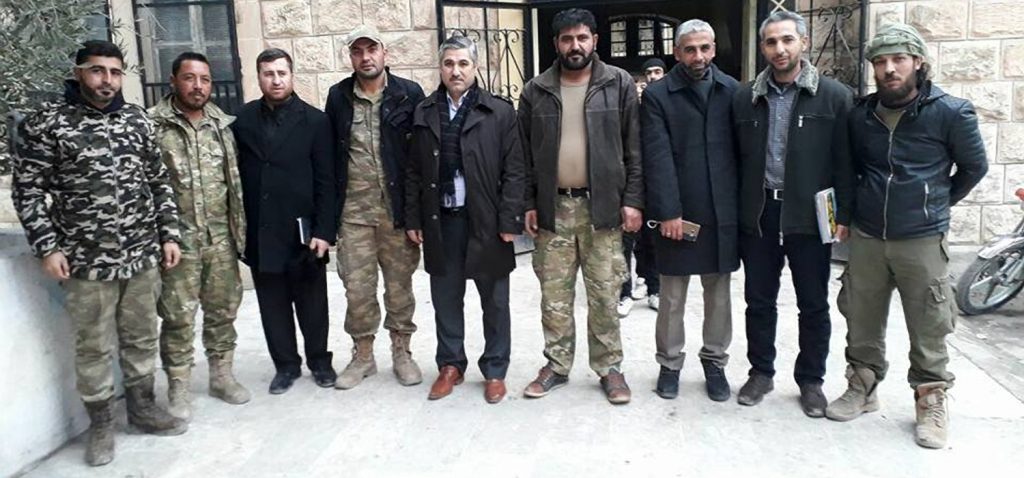
Externally, the Revolutionary Court’s challenges were also severe. For example, some of the larger families and clans in Manbij argued that customary law should apply whenever one of their members was accused of wrongdoing. While clans were weakened after the liberation of Manbij because many sheikhs sided with the regime, some of them still had some influence. In addition, large military factions such as Ahrar al-Sham, the Islamic State, and before them certain FSA groups created their own courts to evade accountability. These courts originally tried fighters accused of wrongdoing. At a later stage, the inhabitants sought them out for other types of cases because they felt that the Revolutionary Court was toothless or too secular.
The multiplicity of courts in Manbij created a conundrum. When a plaintiff or a defendant didn’t agree with the rulings of the Revolutionary Court, nothing prevented him from requesting a new trial at one of the other courts in the city. An increasing number of inhabitants sought the Islamic State’s court because it was much faster in issuing rulings and in implementing them. On several occasions, the Islamic State attacked the Revolutionary Court and captured prisoners. In one instance, the group executed the prisoners publicly to tarnish the reputation of the RC and terrify the population.
Due to these challenges, the RC decided to replace the Revolutionary Court with a Sharia Council in October 2013, which got the support of all the military factions present in the city except for the Islamic State. The RC also created a security brigade to protect the new council and its prison, and to improve security in the city.
But there were now, in reality, three legal systems coexisting in Manbij: the Syrian penal code, sharia, and customary law. Such a space, where several legal systems coexist, is common when the authority of a central state disappears. The experimentation with this plurality might have been productive in other circumstances, especially since previously marginal groups started having a voice. This was not exactly the case in Manbij, however. Force rather than democratic deliberation imposed certain legal discourses and marginalized others. Still, the existence of several legal systems allowed for creative experimentation, and in some instances turned law into an emancipatory rather than a coercive tool.
Conclusion
Manbij’s democratic experiment was not to last. The rending forces of war proved too strong. During my first visit in June and July 2013, the RC was dominating political life in the city while the Islamic State (at the time, known as the Islamic State in Iraq and Syria, or ISIS) was marginal. By December 2013, when I went for a second visit, the Islamic State had become the dominant group and controlled most vital institutions, and the RC had almost ceased operating because the lives of its president and members were constantly threatened. As the opposition fought the Islamic State in northern Syria in 2014, Manbij fell in and out of the extremist group’s hands. After being involved in some activities to resist the Islamic State, including a daring general strike, the RC was ultimately expelled and began operating in exile from Azaz, a city more than one hundred kilometers to the west, near the Turkish border. In August 2016, the Kurdish Democratic Union Party drove out the Islamic State; the RC seems to have grown much closer to Turkey since the country’s military intervention in Syria that same month, and has lost its independence. It has not returned to Manbij.
Manbij’s revolutionaries were marginalized by better-funded and extremely well-organized forces. But this is not a sign that Manbij’s revolutionary governance was necessarily fated, from the beginning, to be short-lived. The unfortunate demise of the RC’s brand of participatory politics was not due to inherent flaws—a failure of its design or implementation—but to external factors.
The unfortunate demise of the RC’s brand of participatory politics was not due to inherent flaws—a failure of its design or implementation—but to external factors.
And one of the biggest root causes of the RC’s undoing was the revolution’s inability to produce a discourse that adequately represented it, in international media and elsewhere. The story has never been told well, either by analysts, pundits, or journalists.
At the international level, the Western and Arab governments have not only intervened militarily to crush the Syrian revolution; they have also produced discourses that besieged the very idea of revolution. The West has advanced its narrative either through complicit silence13, well-orchestrated campaigns to tarnish the image of the revolutionaries,14 or the funding of the most reactionary military factions, such as Ahrar al-Sham and the Islam Army (Jaysh al-Islam).15 Further, many commentators, journalists, and academics write solely about the military and geopolitical dimensions of the uprisings and ignore cultures of liberation and participatory politics that Syrians have been developing and enacting since the early days of the revolts. Even when they have good intentions, a large section of the intelligentsia has used antiquated conceptual tools and inadequate theories.16
It is important that the violence of the war and the hostile narratives promulgated by outsiders do not silence the stories of local practices such as those in Manbij, which were vital spaces for experimentation and the production of new cultures. The local narratives that emanated from the city stand in stark opposition to abstract global designs and regional strategies that commentators regurgitate when they write about Syria.
Local governance and participatory democracy in Manbij were not the products of ideological certainties but rather the contingent outcomes of grassroots resistance. The efforts were imperfect, but they represented the beginning of a long process of liberation—a process that has been undermined, though not necessarily aborted, by foreign interventions and the Syrian regime’s politics of death and destruction. The experimental grassroots politics and micropractices in Manbij and other cities might still represent the beginning of a culture of liberation that could take several decades before reaching fruition. What’s more, Manbij’s revolutionaries have been aware of their experiment’s potential from the beginning, even if they could not have foreseen all the obstacles that would later be thrown in front of them.
Local governance and participatory democracy in Manbij were not the products of ideological certainties but rather the contingent outcomes of grassroots resistance.
As the Syrian civil war finishes its sixth brutal year, a future without Assad is looking ever more unlikely. But there is still wisdom to be gleaned from the efforts of the Manbij revolutionaries, who stumbled not because they made any mistakes in designing their institutions, but because so much of the world turned out to be against them. Throughout the country, revolutionaries’ initial experiments with governance—in Manbij, Idlib, the Eastern Ghouta, and elsewhere—will have enduring benefits for the Syrian people, whose skills and aptitude for participatory politics were expanded, however haltingly, in their interregnum of self-determination. If we are to continue to envision the possibility of a more democratic future in Syria, we would be wise to keep the lessons of places like Manbij alive, as well.
The research for this report was funded by the Arab Council for the Social Sciences (ACSS).
About This Project
This policy report is part of “Arab Politics beyond the Uprisings: Experiments in an Era of Resurgent Authoritarianism,” a multi-year TCF project supported by the Carnegie Corporation of New York. Studies in this series explore attempts to build institutions and ideologies during a period of resurgent authoritarianism, and at times amidst violent conflict and state collapse. The project documents some of the spaces where change is still emerging, as well as the dynamic forces arrayed against it. The collected essays will be published by TCF Press in June 2017.
The research for this report was funded by the Arab Council for the Social Sciences (ACSS).
Banner Image: ©Facebook/Manbij Revolutionary Council
Notes
- The research for this report was funded by the Arab Council for the Social Sciences (ACSS).
- “Manbij Perishes Silently” (Arabic), Syria Untold, July 20, 2016
- As I have noted, I am referring to the Manbij activists who were instrumental in setting up the RC as “revolutionaries,” using the term they used to describe themselves. Similarly, I use other concepts popular among the activists throughout this chapter, such as “liberation.” Although I acknowledge the risk of using normative terms such as these to describe events over which there is still a great deal of disagreement even within Syria, it would be a poor representation of my research to use excessively impartial vocabulary.
- I borrow Haitian intellectual Michel-Rolph Trouillot’s terminology for his country’s “unthinkable revolution” at the turn of the nineteenth century, which was ignored in much of the world due to racism. Analogously, Western thought has ignored the accomplishments of Syrian revolutionaries and—in its ignoring of them—telegraphed the belief that a revolutionary process is inconceivable in an Arab country such as Syria.
- The FSA was very marginal in Manbij and didn’t play any notable role until after the liberation of the city. See Christoph Reuter and Abd al-Kadher Adhun, “Rebels Make a Go of Governing in Liberated City,” Der Spiegel, October 2, 2012
- In general, the FSA in Manbij was ill-equipped and underfunded; it had less than twenty machine guns the day residents expelled the police and security from the city.
- For more on Egypt’s local popular committees, see Cilja Harders and Dina Wahba’s chapter in this volume, “New Neighborhood Power: Informal Popular Committees and Changing Local Governance in Egypt;” and Aysa El-Meehy’s chapter in this volume, “Governance from Below: Comparing Local Experiments in Egypt and Syria after the Uprisings.”
- For more information see Haian Dukhan, “Tribes and Tribalism in the Syrian Uprising,” Syria Studies Journal 6, no. 2 (2014): 1–28.
- Amjad Altinawi, “The Security Establishement Executes ‘The Prince’” (Arabic), All4Syria, April 21, 2015.
- Zana Miso, “Faruq Brigades Leave Homs under Shelling and Head to al-Hasakeh to Fight Kurdish Forces” (Arabic), YouTube, July 23, 2013.
- Rania Abouzeid, “Syria’s Up-and-Coming Rebels: Who Are the Farouq Brigades?,” Time, October 05, 2012.
- Manbij and other regions in northern Aleppo province were dominated by the Naqshbandiyya Sufi order. Salafism had a contentious relationship with Sufism in Syria. For an in-depth discussion, see the important work of Itzchak Weismann on Salafism and Sufism in Syria.
- Christina Zdanowicz, “Aleppo Is Being Destroyed by the Silence of the World,” CNN, December 13, 2016.
- Idrees Ahmad, “Russia Today and the Post-Truth Virus,” Pulsemedia, December 15, 2016.
- Kim Sengupta, “Turkey and Saudi Arabia Alarm the West by Backing Islamist Extremists the Americans Had Bombed in Syria,” The Independent, May 11, 2015.
- Even outlets opposed to Assad and friendly to the opposition tend to overemphasize the geopolitical aspect of the revolution. See the following articles from major outlets that have been generally critical of the Assad regime: As`ad Abukhalil, “The Left and the Syria Debate,” Jadaliyya, December 10, 2016; Max Fisher, “In Syrian War, Russia Has Yet to Fulfill Superpower Ambitions,” The New York Times, September 24, 2016; Nafeez Ahmed, “Syria Intervention Plan Fueled by Oil Interests, Not Chemical Weapon Concern,” The Guardian, August 30, 2013; David Oualaalou, “Russia Outsmarts the U.S. in Syria: A New Geopolitical Outlook,” The Huffington Post, October 13, 2016.




